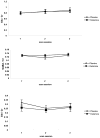The antidepressant effect of ketamine is not associated with changes in occipital amino acid neurotransmitter content as measured by [(1)H]-MRS
- PMID: 21232924
- PMCID: PMC3061550
- DOI: 10.1016/j.pscychresns.2010.10.009
The antidepressant effect of ketamine is not associated with changes in occipital amino acid neurotransmitter content as measured by [(1)H]-MRS
Abstract
The NMDA receptor antagonist ketamine can induce a rapid improvement in depressive symptoms that often endures for days after a single intravenous dose. The pharmacodynamic basis for this effect is poorly understood. Using a proton magnetic resonance spectroscopy ([(1)H]-MRS) method that previously detected a normalization of amino acid neurotransmitter (AANt) content after chronic treatment with conventional antidepressant treatments, we examined whether the acute action of ketamine is associated with alterations in AANt content as well. Ten subjects with major depressive disorder (MDD) received saline, then ketamine in a fixed order, one week apart, under single-blind conditions. Each infusion was associated with three [(1)H] MRS scans (baseline, 3h and 48 h post-infusion) that measured glutamate, GABA and glutamine within the occipital cortex. Rating scales were administered before, during and after each infusion. The rapid (1h) and sustained (at least 7 days) antidepressant effect we observed after ketamine infusion was not associated with either baseline measures of, or changes in, occipital AANt content. Dissociative symptoms were not correlated with changes in depression scores. While our results indicate that changes in occipital AANt content are not a correlate of ketamine's antidepressant action, this may only apply to the regional and temporal windows of our MRS measurements.
Copyright © 2010 Elsevier Ireland Ltd. All rights reserved.
Figures




References
-
- Beck AT, WC, Mendelson M, Mock J, Erbaugh J. An inventory for measuring depression. Arch Gen Psychiatry. 1961;4:53–63. - PubMed
-
- Behar K, Rothman DL, Spencer DD, Petroff OAC. Analysis of macromolecule resonances in 1H NMR spectra of human brainMagn Reson Med. Magn Reson Med. 1994;32:294–302. - PubMed
-
- Berman RM, Cappiello A, Anand A, Oren DA, Heninger GR, Charney DS, Krystal JH. Antidepressant effects of ketamine in depressed patients. Biological Psychiatry. 2000;47(4):351–354. - PubMed
-
- Breier A, Malhotra AK, Pinals DA, Weisenfeld NI, Pickar D. Association of ketamine-induced psychosis with focal activation of the prefrontal cortex in healthy volunteers. Am J Psychiatry. 1997;154(6):805–811. - PubMed
-
- Brunner E, Domhof S, Langer F. Nonparametric analysis of longitudinal data in factorial experiments. New York, NY: John Wiley and Sons; 2002.
Publication types
MeSH terms
Substances
Grants and funding
LinkOut - more resources
Full Text Sources
Other Literature Sources
Medical

